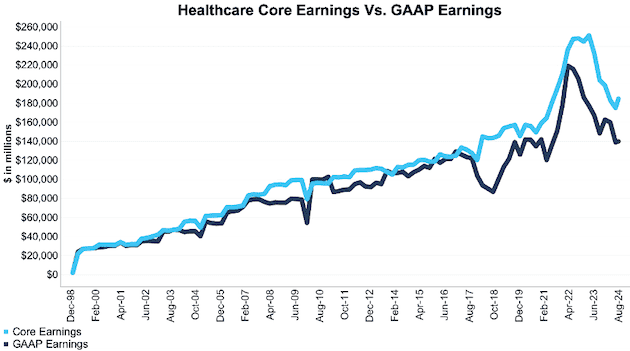We have updated the trailing-twelve-month (TTM) Core Earnings and GAAP Earnings for the NC 2000 and all sectors for 2Q24.
Movement in Core Earnings and GAAP earnings were different again this quarter, which raises red flags about the quality of reported earnings. These results underscore the more stable nature of Core Earnings. Because we remove unusual gains and losses, Core Earnings are not as volatile as GAAP Earnings.
This report is an abridged and free version of All Cap Index & Sectors: GAAP Vs. Core Update for 2Q24, one of our quarterly reports on fundamental market and sector trends.
The full version of the report analyzes Core Earnings[1][2] and GAAP earnings of the NC 2000 and each of its sectors (last quarter’s analysis is here) from 1998 to present. The full reports are available to Institutional members.
This report leverages our cutting-edge Robo-Analyst technology to deliver proven-superior fundamental research and support more cost-effective fulfillment of the fiduciary duty of care.
GAAP Earnings Are Again Misleading in 2Q24
Our superior fundamental data protects investors from being fooled by misleading trends in GAAP Earnings. The recent rise in GAAP Earnings understates the rise in Core Earnings for the NC 2000.
When GAAP earnings and Core Earnings diverged last quarter, we thought we might see the kitchen sink effect accentuate that divergence. So, this quarter’s results are even more interesting. See Figure 1 in the full report.
GAAP Earnings Understate Core Earnings for Over Half of the NC 2000 (by Market Cap)
For the TTM ended 2Q24, 57% of the companies in the NC 2000 reported GAAP Earnings that are lower than Core Earnings.
When GAAP Earnings are lower than Core Earnings, they are understated by an average of 176%, per Figure 1.
Figure 1: NC 2000 GAAP Earnings Understated by 176% On Average
Sources: New Constructs, LLC and company filings.
We use Funds from Operations (FFO) for Real Estate companies rather than GAAP Earnings.
Key Details on Select NC 2000 Sectors
Five of eleven sectors saw a QoQ rise in Core Earnings through the TTM ended 2Q24.
The Healthcare sector saw the largest QoQ improvement in Core Earnings.
The Technology sector generates the most Core Earnings. On the flip side, the Real Estate sector has the lowest Core Earnings.
To give you a sense of what we show in the full report, we provide a snippet on the Healthcare sector, below.
The full report provides these details and charts on the S&P 500 and all sectors.
Sample Sector Analysis[3]: Healthcare Sector
Figure 2 shows Core Earnings for the Healthcare sector rose 7% QoQ in 2Q24, while GAAP earnings rose 2% over the same time.
Figure 2: Healthcare Core Earnings Vs. GAAP: 1998 – 2Q24
Sources: New Constructs, LLC and company filings.
Our Core Earnings analysis is based on aggregated TTM data for the sector constituents in each measurement period.
The August 15, 2024 measurement period incorporates the financial data from calendar 2Q24 10-Qs, as this is the earliest date for which all of the calendar 2Q24 10-Qs for the NC 2000 constituents were available.
This article was originally published on September 5, 2024.
Disclosure: David Trainer, Kyle Guske II, and Hakan Salt receive no compensation to write about any specific stock, style, or theme.
Questions on this report or others? Join our online community and connect with us directly.
Appendix: Calculation Methodology
We derive the Core Earnings and GAAP Earnings metrics above by summing up the trailing-twelve-month individual NC 2000 constituent values for Core Earnings and GAAP Earnings in each sector for each measurement period. We call this approach the “Aggregate” methodology.
The Aggregate methodology provides a straightforward look at the entire sector, regardless of market cap or index weighting and matches how S&P Global (SPGI) calculates metrics for the S&P 500.
[1] Core Earnings enable investors to overcome the flaws in legacy fundamental data and research, as proven in Core Earnings: New Data & Evidence, written by professors at Harvard Business School (HBS) & MIT Sloan for The Journal of Financial Economics.
[2] Based on the latest audited financial data, which is the 2Q24 10-Q in most cases. Price data as of 8/15/24. QoQ analysis is based on the change since last quarter.
[3] The full version of this report provides analyses for all eleven sectors.


